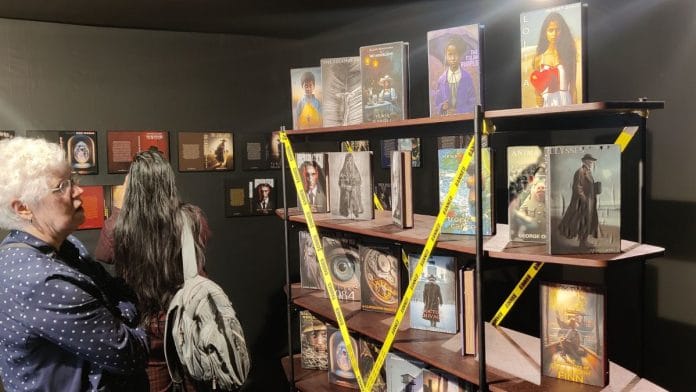New Delhi: Salman Rushdie gazes knowingly at the viewer—his name scrawled in red over his blackened glass lens like an eyepatch, and Satanic Verses pasted in block letters across the image. “He is one of the most vilified authors in recent times. In fact, he is the poster boy of banned books,” says artist and photographer Rohit Chawla as he oversees the setting up of his new installation, ‘Banned’, at the India Habitat Centre in New Delhi.
Rows of books, from Vladimir Nabakov’s Lolita to Alice Walker’s The Color Purple and Bret Easton Ellis’ American Psycho sit on a stark bookshelf. Curated by Alka Pande, the installation is a whirlwind tour of censorship, changing ideals of morality and government control. A Black girl grips a cup of tea in the re-imagined cover of Lewis Carroll’s Alice’s Adventures in Wonderland. And a woman emerges from a giant frond in a black and white photo of Simone De Beavoir’s The Second Sex. All these books have experienced censorship at some point.
Ever since the first book was printed, censorship has existed, explains Chawla’s note outside the exhibit. Even versions and translations of the Bible faced bans.
“The idea of banned books has been lying dormant in my head for a long time, and I felt this was the right political time to do this,” says Chawla.
‘Banned’ is Chawla’s answer to the debate on freedom of expression and censorship. It’s also a tribute to authors who refuse to remain silent. Rushdie has faced fatwas and survived a horrific stabbing. Marjane Satrapi’s Persepolis turned 20 last August, but this coming-of-age story of a girl who grew up in Iran during the 1979 revolution remains controversial. In Chawla’s re-imagined cover of this graphic novel, a girl in a clear shroud gazes boldly at the viewer—without fear.
“They are all the more enticing because they are banned. If you have read them, you have done justice to your life,” said Ahtushi Deshpande, an author and photographer who had come to IHC to see the installation.

Also read: Chennai’s Museum of Possibilities turns Universal Design into a show-and-tell
Censorship in digital era
E-books on platforms like Telegram and torrents have diluted the impact of censorship. A book, a movie, or a documentary being banned in a country doesn’t mean that citizens don’t have access to it. But the watering down of banishment through technology has not reduced censorship—even in countries like the US.
A PEN report found that there were 3,362 cases of books being removed from schools and classroom libraries during the 2022-2023 school year, a 33 per cent increase over the previous school year. More than 1,550 individual titles were targeted.
The installation caught the attention of many audience members, who walked into the room, which was designed like a crime scene. Yellow tapes with the signage ‘banned’ on them criss-crossed the bookshelf.
“We live in an age of self-censorship, and a pervasive ban culture that exists in all Right-wing governments across the world. Public memory needs to be exercised to know that even the most innocuous books were banned,” says Chawla.
In the US, Penguin Random House has started hosting anti-book-banning events, giving away copies of its most frequently banned titles, and putting its weight behind a letter-writing campaign targeting local and school board officials.
People watching the art installations also discussed among themselves the number of books displayed that they had managed to read and were also surprised by some others.
“American Psycho is one of my favourite Christian Bale movies, and I had no idea it was based on a once-banned book. Gives a whole new dimension to it,” says Achyut Pande, a Delhi University student. The book was deemed too violent when it was published but was later adapted into a movie. Pande, who is an avid cinephile, took a few photos of the books he was particularly intrigued by, including Gustave Flaubert’s Madame Bovary.

Many viewers paused in front of their personal favourites—either in the form of physical books on the shelf or as photographs, in the shape of book covers on panels, with the author’s note next to the image. “This is even more relevant considering censored book covers continue to remain so vocally etched in the minds of the public for their ferocity amidst controversy,” said Sweta Kushwaha, Assistant Professor at Guru Gobind Singh Indraprastha University (GGSIPU), New Delhi.
But Chawla is also aware that reading is fading as a habit, among a generation hooked on reels and social media. But it’s not quite dead yet– As per a survey, Indians clocked 10.4 hours of weekly reading and 1.5 hours of daily reading.
“People who were readers earlier are now writing good shows, and watching them too,” he says.
While the younger members of the audience were more fascinated by the covers themselves, many were transported back in time when they had first read the books on display. “The Good Earth moved me and brought me to tears when I read it. This installation feels like a throwback to the kind of effect they had on me when I read them,” said Deshpande.
As the first installation, placed at the entry point of the Art of India show, ‘Banned’ had many curious about the presence of books there. And some viewers stopped, stood back, and observed a moment of silence to acknowledge the men and women who defied society.
“These authors pushed the boundaries of what we look at as a conventional society and later accepted because of their forthright commentary. Thanks for reminding us that we need to be more open-minded as a society,” said Shantum Seth, co-founder of the Ahimsa Trust.






